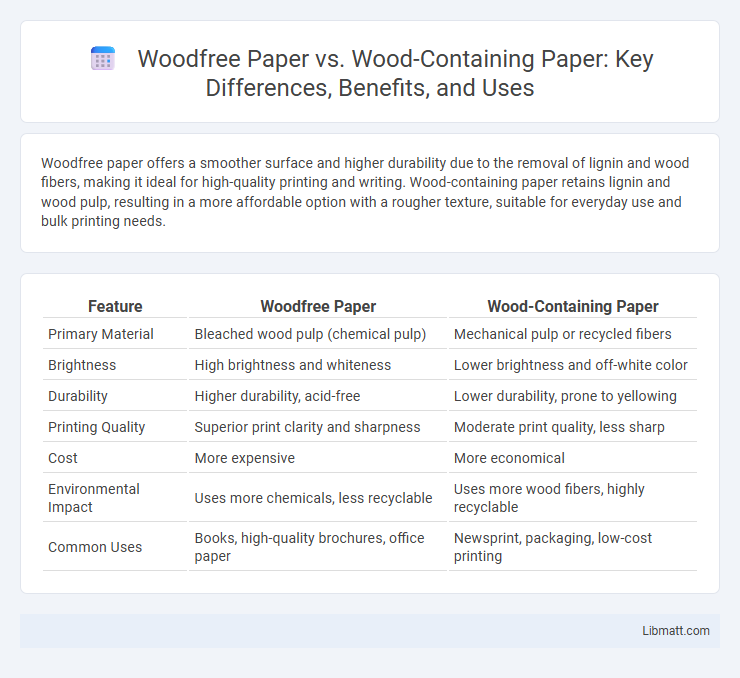Woodfree paper offers a smoother surface and higher durability due to the removal of lignin and wood fibers, making it ideal for high-quality printing and writing. Wood-containing paper retains lignin and wood pulp, resulting in a more affordable option with a rougher texture, suitable for everyday use and bulk printing needs.
Table of Comparison
| Feature | Woodfree Paper | Wood-Containing Paper |
|---|---|---|
| Primary Material | Bleached wood pulp (chemical pulp) | Mechanical pulp or recycled fibers |
| Brightness | High brightness and whiteness | Lower brightness and off-white color |
| Durability | Higher durability, acid-free | Lower durability, prone to yellowing |
| Printing Quality | Superior print clarity and sharpness | Moderate print quality, less sharp |
| Cost | More expensive | More economical |
| Environmental Impact | Uses more chemicals, less recyclable | Uses more wood fibers, highly recyclable |
| Common Uses | Books, high-quality brochures, office paper | Newsprint, packaging, low-cost printing |
Introduction to Woodfree and Wood-Containing Paper
Woodfree paper is made primarily from chemical pulp that has most lignin removed, resulting in a smoother, brighter, and more durable surface ideal for high-quality printing and writing. Wood-containing paper, often produced from mechanical pulp, retains more lignin, making it less bright and more prone to yellowing but typically more cost-effective for everyday printing and packaging. Your choice between woodfree and wood-containing paper depends on the desired print quality, durability, and budget considerations.
What is Woodfree Paper?
Woodfree paper is a high-quality paper made from chemical pulp that has most lignin and impurities removed, resulting in greater brightness, smoothness, and durability compared to wood-containing paper. Unlike wood-containing paper, which includes mechanical pulp with lignin, woodfree paper resists yellowing and degradation over time, making it ideal for printing, writing, and archival purposes. When choosing paper for professional documents or artwork, your preference for longevity and clarity often makes woodfree paper the superior option.
What is Wood-Containing Paper?
Wood-containing paper is made using raw wood fibers that retain lignin, a natural polymer found in trees, which contributes to its lower cost and different aging properties compared to woodfree paper. Unlike woodfree paper, which has lignin removed during processing to enhance whiteness and durability, wood-containing paper tends to yellow and become brittle over time due to the lignin content. Your choice between wood-containing and woodfree paper should consider factors like print quality, longevity, and environmental impact, with wood-containing paper often favored for economical, short-term applications.
Key Differences Between Woodfree and Wood-Containing Paper
Woodfree paper is made primarily from chemical pulp, which removes lignin and results in higher brightness, smoother surface, and greater durability compared to wood-containing paper that includes mechanical pulp with lignin. The absence of lignin in woodfree paper reduces yellowing and enhances archival quality, making it ideal for printing and writing applications requiring longevity. In contrast, wood-containing paper is more cost-effective but prone to faster discoloration and lower structural strength due to residual lignin content.
Manufacturing Processes
Woodfree paper undergoes chemical pulping processes such as kraft or sulfite methods to remove lignin, resulting in higher brightness and durability. Wood-containing paper is typically produced through mechanical pulping, which retains lignin and cellulose fibers, leading to lower cost but reduced longevity. The chemical treatment in woodfree paper manufacturing enhances smoothness and print quality, making it preferred for high-end printing applications.
Quality and Durability Comparison
Woodfree paper, primarily composed of chemical pulps with minimal lignin content, exhibits superior quality and durability compared to wood-containing paper, which retains higher lignin levels leading to faster degradation and yellowing. The chemical process used in woodfree paper enhances fiber strength, resulting in smoother texture, higher brightness, and increased resistance to aging and brittleness. Conversely, wood-containing paper, often produced via mechanical pulping, tends to have lower opacity, reduced longevity, and decreased dimensional stability due to lignin's acidic nature.
Environmental Impact and Sustainability
Woodfree paper significantly reduces environmental impact by utilizing chemical pulping processes that remove lignin, resulting in higher quality paper with fewer impurities and increased recyclability. Wood-containing paper, produced from mechanical pulping, retains lignin, leading to faster degradation and difficulty in recycling, which contributes to higher waste and deforestation rates. Choosing woodfree paper supports sustainability goals by promoting efficient resource use and lowering your ecological footprint through improved recyclability and reduced dependency on raw wood fibers.
Common Uses and Applications
Woodfree paper is commonly used for high-quality printing purposes such as books, brochures, and office stationery due to its smoother surface and durability. Wood-containing paper, often cheaper and more absorbent, is frequently employed in packaging, newspapers, and everyday print materials where cost efficiency is prioritized. Your choice between these papers depends on the intended application, balancing quality needs with budget considerations.
Cost Considerations
Woodfree paper typically incurs higher production costs due to the removal of lignin and other impurities, resulting in a smoother and brighter finish compared to wood-containing paper. Wood-containing paper is generally more cost-effective, as it retains lignin, reducing processing expenses and making it ideal for bulk printing or budget-conscious projects. Your choice depends on balancing the desirable print quality of woodfree paper with the economic benefits of wood-containing options.
Which Paper Type is Right for Your Needs?
Woodfree paper offers a smoother, brighter finish and better print quality due to the absence of lignin, making it ideal for professional documents and high-quality prints. Wood-containing paper, often more affordable and eco-friendly, retains natural fibers, providing durability for everyday use and packaging. Assess your printing needs and budget to determine whether the premium look of woodfree or the sustainability and cost-efficiency of wood-containing paper suits your requirements.
Woodfree paper vs wood-containing paper Infographic

 libmatt.com
libmatt.com